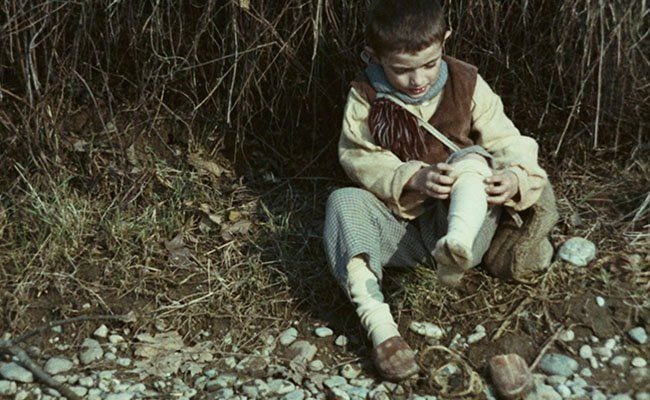
Italian director Ermanno Olmi spent most of his career making documentaries, but is best known today for his 1978 feature film, The Tree of Wooden Clogs, which draws from his extensive experience with non-fiction filmmaking to tell a story that seems truer than life itself. The Tree of Wooden Clogs, which Olmi wrote, shot, directed, and edited, follows the lives of a group of peasants in Lombardy (northern Italy) over the course of a year. Set near the end of the 19th century, the film recreates their traditional way of life in all its beauty and cruelty.
The title comes from a small incident that has vast consequences, bringing to mind that old rhyme about how a kingdom was lost “all for the want of a horseshoe nail.” In The Tree of Wooden Clogs, the chain of events starts with the village priest telling a peasant family that their son Minec (Omar Brignoli, like most of the cast a non-professional from the Bergamo region where the story is set) is bright and should attend the village school. The father is reluctant because he was planning to put the boy to work; the family has a new baby on the way. But the priest says it’s God’s will, so it’s off to school for little Minec, who must walk the eight-mile round trip each day, through all kinds of weather, in his handmade wooden clogs.
As Minec is leaving school one day, one of his clogs breaks. He tries tying it together with the rope that normally serves as his belt, but walking so far on a broken shoe is a terrible chore, and he ends up finishing the trip with one shoe off and one shoe on. This is clearly not a sustainable solution, and if he is to continue attending school, he must have a new pair of clogs. To get the wood to make them, his father Batisti (Luigi Ornaghi) must cut down a tree.
The tree belongs to the landlord (as he does nearly everything on the tenant farm where Minec and his family live), and when he discovers the “theft”, the family is evicted. The last scenes show them loading a cart with their possessions, in the dim moonlight, while the other tenant families watch from behind closed their curtains. There’s no discussion and no explanation because these peasants live in a world of absolutes and cruel consequences, and if an entire family’s future is destroyed due to the cutting of a single tree, then that’s simply how things are.
The story of Minec and his clogs provides the scaffolding for The Tree of Wooden Clogs, but the film’s real subject is the daily life of the tenant farmers, which is recreated in extraordinary detail. The experience of watching this film is something like visiting a historical site staffed with re-enactors who demonstrate how people lived and worked in a different century, from planting and harvesting their crops to doing the laundry and bathing in a wooden bucket. The famous pig-slaughtering scene, which lasts about eight minutes, is presented as simply one more aspect of life as lived by these peasants and is not in the least gratuitous. At just over three hours long, the slow-paced The Tree of Wooden Clogs will try the patience of some modern viewers, but it’s worth giving the film a chance, to settle into its rhythms and take a virtual journey into a time and place where the pace of life was quite different than it is today.
The lives of the peasant families in The Tree of Wooden Clogs are hard, but also rich and full of joy. They are free of modern existential dilemmas regarding who they are and what they should do, and take pleasure in the most basic aspects of life: a warm fire, a good meal, the love of family and a close sense of community. Rites of passage, like marriage and childbirth, loom large in their world, as do the rituals of Catholicism, which are as much a part of daily life as breathing.
The Tree of Wooden Clogs won a number of international awards, including the Palme d’Or and the Prize of the Ecumenical Jury at Cannes, and the Flaherty Documentary Award from BAFTA (a highly appropriate choice, given what we know about how Flaherty scripted and cast his documentaries).
The extras package for The Tree of Wooden Clogs is skimpy by Criterion standards. It includes a video introduction by Mike Leigh (7 min.), who not surprisingly is a big fan of the film; a 1981 episode of The South Bank Show (52 min.) in which host Melvyn Bragg and Olmi discuss the film and visit the farm where it was shot; two interviews with Olmi, conducted in 1978 (7 min.) and 2008 (32 min.); a panel discussion with some cast and crew members held at the 2016 Cinema Ritrovato archival film festival (34 min.); and the film’s trailer (apparently unrestored, making a notable contrast with the beautiful 4K restoration of the film proper which appears on this disc). An illustrated liner insert includes an essay by film critic Deborah Young that reviews Olmi’s career and places this film within the context of his, and other filmmakers’, work.

